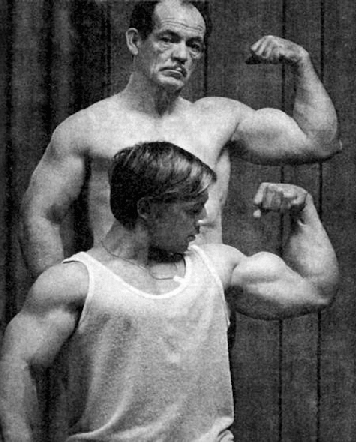
Click Here for Free Bodybuilding and Fitness Magazine Subscription
How Often Should You Work Out
Andro-Shock Works!
I don't have the perfect genes for bodybuilding, nor do I have a lot of time to eat the right way. Using the Andro-Shock product however I really have seen excellent returns on my workout time in the gym. I usually work 55 plus hours a week and workout at 5:30 in the morning before work. Not the ideal circumstances for good nutrition or working out. Yet my flat bench went from 225 lbs to 285. And as of last week I went up to 290 lbs. My arms have grown almost 2". I have noted increases in all body sets. And what amazes me is that I haven't got the shaky feeling I used to get from other Andro products that have been made illegal. Thanks for a non-steroid based product that actually works.
Mike Ronnebaum
For more info on Andro-Shock and how you can get our awesome Free course on "How To Boost Your Testosterone Levels Naturally", visit https://www.trulyhuge.com/andro-sh.htm
You can also order Andro-Shock by calling 800-635-8970 or 503-648-1898, 10 am to 6 pm PST
How Often Should You Work Out with High-Intensity Training

Most hardcore lifters LOVE being in the gym, and we’d spend even more time there than we already do if we could manage it. While all those hours slinging iron help build our bodies, the irony is that extravagant workout frequency and volume can actually stifle muscular growth.
Luckily, taking an analytical approach to your routine can help rein in your volume and relying on a solid training framework can help you dial in your ideal frequency.
One of the protocols that deals most directly with frequency and volume is high-intensity training, or HIT. Here is how to determine how often you should work out when using HIT.
Body-Part v. Workout Frequency
Before you can determine your ideal training frequency, its worthwhile to consider that there are (at least) two kinds of training frequency: how often you work out and how often you work a particular body part, like chest or back.
If you read muscle magazines or websites, you already know that most professional bodybuilders train just a couple of body parts per session and perform each workout just once a week. They’re in the gym nearly every day, but each muscle is hit infrequently — once every seven days, or so, but with tons of volume.
On the other hand, some studies like this one out of the City University of New York show that training more body parts in a session, and more frequently, may yield better results for the average lifter.
Traditional HIT
“Old-school” high-intensity training, as developed by Arthur Jones in the 1970s and carried forward by Dr. Ellington Darden in later years, falls more in line with the routines that the CUNY researchers employed in their study.
In particular, the original HIT had trainees lifting three non-consecutive days a week (Monday, Wednesday, Friday, for example) and training the whole body in each session. This is a very workable and productive schedule for most, because it gives each body part frequent stimulation but limits your volume to just one or two sets per muscle at a time. That leaves your overall volume at just 10-12 set.
By building more rest days than training days into each week, you also help your systemic recovery. In general, an individual muscle will recover from a workout faster than your nervous system and other major body functions.
You need to strike a balance, then, between training each muscle enough to keep growth coming but also giving your whole body time to rest.
Regulating Frequency Over Time
While three full-body workouts work well for many beginning HIT lifters, most guys find that it’s not ideal over the long haul. As you get stronger and make greater demands on your body, it becomes harder and harder to recover, systemically, between workouts.
One approach to solving this problem is to systematically reduce frequency and volume over the course of several months and years to accommodate your bigger and stronger muscles. While this tactic does work for most lifters, you have to be really careful about becoming too minimalist in your training.
Some HIT supporters, like pro bodybuilder Mike Mentzer and his consolidated training, have taken the reduced frequency and volume to an extreme, often working out for just a few minutes once a week, or even every two weeks!
This inevitably leads to smaller, flatter muscles, which doesn’t jibe with the goals of a serious bodybuilder.
Many natural trainees, though, have found a happy medium that allows them to train 2-3 days a week, but has them performing different exercises each training day. Often, they ARE training their entire bodies in each session, but using a variety of movements to do so. You can keep your training even fresher using this approach by changing your exercises on a fairly regular basis, say every month or two.
One other tactic that can make this type of “full-body split” routine even more effective is to include an occasional day of not-to-failure (NTF) training. This allows you to really focus on your form and stimulate your muscles without placing a ton of extra burden on your nervous system.
As much as some of us would like to live in the gym, that’s not a healthy or productive approach to exercise. By intelligently regulating volume and intensity, though, there is no reason that 2-3 hard HIT sessions a week can’t yield great results over many years of happy lifting.
ant Even More HIT Information?If you want to learn ALL about high-intensity training and how to do it the right way, be sure to check out https://www.trulyhuge.com/arthur-jones-nautilus-bulletins.html.

